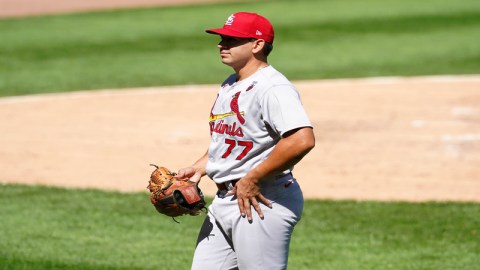FOXBOROUGH, Mass. — The life of a long snapper can be a little bit backward. That is, no one really grows up dreaming about becoming a long snapper. More often than not, it just kind of happens.
The New England Patriots have a good battle going at the long snapper position during their preseason camp. Nathan Hodel, who signed as a free agent after spending seven seasons with the Arizona Cardinals, and rookie Jake Ingram, a sixth-round pick out of Hawaii, appear to be in a dead heat with a week and a half remaining until roster cuts. The winner will replace Lonie Paxton, the Patriots’ long snapper for nine seasons before signing with the Denver Broncos last winter.
It’s been a friendly competition between Hodel and Ingram, a pair of down-to-earth guys who have been willing to help one another in any way possible. That seems to be the status quo for the league’s long snappers, who are typically genuine, unassuming and chock-full of humility. While that should be expected for players who receive no individual glory, the intensity of their one-on-one battle — after all, there are only 32 long-snapping jobs in the world — might be enough to break someone with a lesser character.
Ingram, a laid-back surfing junky from Hawaii, attended his state university as a defensive end. As a backup during his freshman year, though, he faced a lot of downtime at practice and began messing around as a long snapper on the sidelines. When Hawaii’s starting long snapper suffered an injury a few weeks later, head coach June Jones promoted Ingram, whom he considered one of his finest athletes.
“I just could kind of do it,” Ingram said of long snapping. “I just picked up long snapping as I went — at practice, reading things online and tried it out. It was just kind of weird the way it all worked out.”
Hodel had a similar story. He went to the University of Illinois knowing he’d be the team’s long snapper, but he also pitched for the baseball team. Equipped with a 92 mph fastball, a 12-to-6 curveball and a biting slider (he didn’t have much of a changeup, though, as the only two he threw in his career were launched for home runs), Hodel dreamed of the major leagues, and he said baseball remains his first love.
But he was signed to the Carolina Panthers’ practice squad in 2001 before winding up with Arizona later that season. It didn’t take too long for him to figure out he had a career on the gridiron.
“I could throw it hard,” said Hodel, who is still hoping to get to Fenway Park for the first time. “I didn’t quite know where it was going, though. I think I’m a better baseball player than I am a football player, but I always grew up thinking about playing pro baseball and not so much football. But you do what life gives you, and I’m not complaining.”
While each long snapper has taken a roundabout way to his current trade, it’s perhaps fitting that the position itself went through a few twists and turns before becoming such a highly specialized priority for each team in the NFL. Until the mid- to late-1970s, most teams relied on position players such as centers, linebackers or tight ends to double as long snappers. It wasn’t really until the end of the 1970s when the position became so specialized.
“When I first came into the league, I’d say there were a couple long snappers in the league, and then most teams had a position player that snapped,” said Patriots head coach Bill Belichick, who broke into the league as a special assistant with the Baltimore Colts in 1975 before he was hired as the Detroit Lions’ special teams coach in 1976. “Even if you look at the Pro Bowl voting — I’m not sure exactly when that changed, but I’d say probably 10-15 years ago, it hasn’t been that long — where the rule was you had to select a player [for your ballot] who was a position player to be your long snapper. When you sent in your ballot, you had to include somebody who was a snapper so that each team would have one or they’d pick one. At some point — I can’t remember exactly when it was — they went to just strictly selecting a long snapper because in all honesty, those players didn’t snap anymore. It just got phased out.”
This happened for a few specific reasons. First of all, the rosters have expanded by nearly a dozen players in the last three decades, which has spread out nearly everybody’s role. For instance, now, there are third-down running backs and pass-rushing linebackers when such a commodity was almost unheard of years ago.
Second, injuries can become an issue. If a team’s linebacker doubles as a long snapper, and that linebacker rips his knee apart, that team must be prepared with a backup long snapper. Taking that a step further, you’re talking about devoting more midweek practice time toward an emergency situation that could take away from a players' growth in fundamental football.
Third, there is a desirable skill level involved. A bad snap can cost a team a game, and as the New York Giants found out during a 2002 Wild Card loss to the San Francisco 49ers, an errant long snapper can sabotage an entire season. Conversely, you can’t even think of a bad snap from Paxton, who executed the snaps on each of Adam Vinatieri’s Super Bowl field goals — along with his two decisive kicks in the Patriots’ 2001 playoff victory against the Oakland Raiders, when Paxton famously celebrated by making a snow angel in the end zone.
It’s also become too difficult for today’s traditional offensive linemen to be relied upon as long snappers. And in the simplest sense, it’s because of the size of their pads.
“If you look at these offensive linemen — you just look at them out there on the field — they’ve got shoulder pads on that would protect them from an 18-wheeler,” Belichick said.
Even New England’s Dan Koppen, one of the NFL’s most talented centers, couldn’t get the logistics down. He tried long snapping during his first practice as a freshman at Boston College, and as he put it, “I couldn’t do it, so I haven’t tried it since.”
So, with all of those factors, the long snapper was born. Sure, they’ll help out the scout team during practices, but long snappers are in camp for one thing and one thing only. The days can get long and monotonous, with Ingram and Hodel often working alone on the sideline while the rest of the team is broken off into larger groups or 11-on-11 drills.
“I’ll contribute and do as much as I can on the look squads and everything, but I’m definitely here to snap the football,” Ingram said. “I’m a specialist. I’m a little different, not really a position player. You’re here to do one thing, and you’ve got to do it well or you’re not going to stick around.”
And as Ingram and Hodel will echo, if the checks still cash, they’ll be more than happy to keep on snapping.
“As the league gets more specialized, everybody is trying to find that edge to try to find out a way to win a game,” Hodel said. “On punts and field goals, the little bit of timing discrepancy there would be if a snap was off or something, people would use that to their advantage. You needed guys to come in and be really consistent at it, and I think that’s kind of where it came out of. I’m glad it did because it got me a job for awhile."



